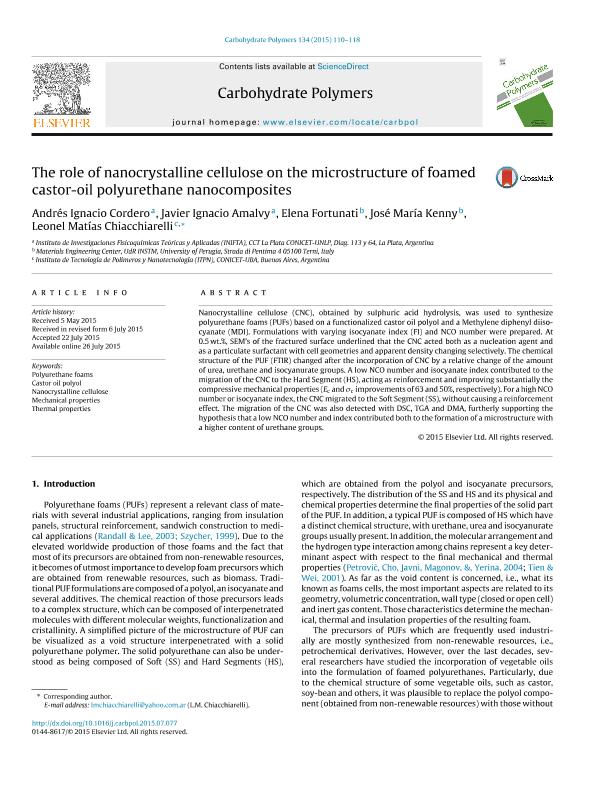Artículo
The role of nanocrystalline cellulose on the microstructure of foamed castor-oil polyurethane nanocomposites
Cordero, Andrés Ignacio ; Amalvy, Javier; Fortunati, Elena; Kenny, José María; Chiacchiarelli, Leonel Matias
; Amalvy, Javier; Fortunati, Elena; Kenny, José María; Chiacchiarelli, Leonel Matias
 ; Amalvy, Javier; Fortunati, Elena; Kenny, José María; Chiacchiarelli, Leonel Matias
; Amalvy, Javier; Fortunati, Elena; Kenny, José María; Chiacchiarelli, Leonel Matias
Fecha de publicación:
11/2015
Editorial:
Elsevier
Revista:
Carbohydrate Polymers
ISSN:
0144-8617
Idioma:
Inglés
Tipo de recurso:
Artículo publicado
Clasificación temática:
Resumen
Nanocrystalline cellulose (CNC), obtained by sulphuric acid hydrolysis, was used to synthesize polyurethane foams (PUFs) based on a functionalized castor oil polyol and a Methylene diphenyl diisocyanate (MDI). Formulations with varying isocyanate index (FI) and NCO number were prepared. At 0.5 wt.%, SEM's of the fractured surface underlined that the CNC acted both as a nucleation agent and as a particulate surfactant with cell geometries and apparent density changing selectively. The chemical structure of the PUF (FTIR) changed after the incorporation of CNC by a relative change of the amount of urea, urethane and isocyanurate groups. A low NCO number and isocyanate index contributed to the migration of the CNC to the Hard Segment (HS), acting as reinforcement and improving substantially the compressive mechanical properties (Ec and σc improvements of 63 and 50%, respectively). For a high NCO number or isocyanate index, the CNC migrated to the Soft Segment (SS), without causing a reinforcement effect. The migration of the CNC was also detected with DSC, TGA and DMA, furtherly supporting the hypothesis that a low NCO number and index contributed both to the formation of a microstructure with a higher content of urethane groups.
Archivos asociados
Licencia
Identificadores
Colecciones
Articulos(ITPN)
Articulos de INSTITUTO DE TECNOLOGIA EN POLIMEROS Y NANOTECNOLOGIA
Articulos de INSTITUTO DE TECNOLOGIA EN POLIMEROS Y NANOTECNOLOGIA
Citación
Cordero, Andrés Ignacio; Amalvy, Javier; Fortunati, Elena; Kenny, José María; Chiacchiarelli, Leonel Matias; The role of nanocrystalline cellulose on the microstructure of foamed castor-oil polyurethane nanocomposites; Elsevier; Carbohydrate Polymers; 134; 11-2015; 110-118
Compartir
Altmétricas



